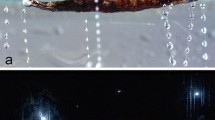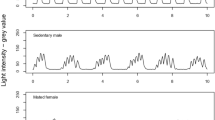Abstract
We investigated the hypothesis that bioluminescence in firefly larvae (Coleoptera: Lampyridae) functions as an aposematic display. In two experiments, we confirmed the distastefulness of firefly larvae, and tested the hypothesis that a naive, nocturnal predator can learn to use light signals as aposematic cues for avoiding distasteful prey. Larvae were rejected as acceptable prey by 100% of the house mice (Mus musculus) tested. Mice learned to avoid bitter food associated with light cues significantly faster (P=0.003) than mice presented with food lacking light cues. We conclude that luminescent glowing in firefly larvae meets the requirements of an aposematic signal.
Similar content being viewed by others
References
Branham, M. C., and Greenfield, M. D. (1996). Flashing males win mate success.Nature 381: 745–746.
Carlson, A. D., and Copeland, J. (1978). Behavioral plasticity in the flash communication systems of fireflies.Am. Sci. 66: 340–346.
Eisner, T., Wiemer, D. F., Haynes, L. W., and Meinwald, J. (1978). Lucibufagins: Defensive steroids from the firefliesPhotinus ignitus andP. marginellus (Coleoptera: Lampyridae).Proc. Natl. Acad. Sci. 75: 905–908.
Gittleman, J. L., and Harvey, P. H. (1980). Why are distasteful prey not cryptic?Nature 286: 149–150.
Grober, M. S. (1988). Brittle-star bioluminescence functions as an aposematic signal to deter crustacean predators.Anim. Behav. 36: 493–501.
Grober, M. S. (1989). Bioluminescent aposematism: A reply to Guilford and Cuthill.Anim. Behav. 37: 341–343.
Guilford, T. (1990). The evolution of aposematism. In Evans, D. L., and Schmidts, J. O. (eds.),Insect Defenses: Adaptive Mechanisms and Strategies of Prey and Predators, State University of New York Press, Albany, pp. 24–61.
Guilford, T., and Cuthill, I. (1989). Aposematism and bioluminescence.Anim. Behav. 37: 339–341.
Harvey, E. H. (1952).Bioluminescence, Academic Press, New York.
Huber, M. E., Arneson, A. C., and Widder, E. A. (1989). Extremely blue bioluminescence in the polychaetePolycirrus perplexus (Terebellidae).Bull. Mar. Sci. 44: 1236–1239.
Lloyd, J. E. (1973). Firefly parasites and predators.Colepts. Bull. 27: 91–106.
Lloyd, J. E. (1975). Aggressive mimicry inPhoturis fireflies: Signal repertoires by femmes fatales.Science 187: 452–453.
Lloyd, J. E. (1983). Bioluminescence and communication in insects.Annu. Rev. Entomol. 28: 131–160.
McLean, M., Buck, J., and Hanson, F. E. (1972). Culture and larval behavior of photurid fireflies.Am. Midl. Nat. 87: 133–145.
Sivinski, J. (1981). The nature and possible functions of luminescence in Coleoptera larvae.Coleoptera larvae. Coleopts. Bull. 35: 167–179.
Sydow, S. L., and Lloyd, J. E. (1975). Distasteful fireflies sometimes emetic but not lethal.Fla. Entomol. 58: 312.
Whitaker, J. O., Jr. (1963). Food of 120Peromyscus leucopus from Ithaca, New York.J. Mammal. 44: 418–419.
Author information
Authors and Affiliations
Rights and permissions
About this article
Cite this article
Underwood, T.J., Tallamy, D.W. & Pesek, J.D. Bioluminescence in firefly larvae: A test of the aposematic display hypothesis (Coleoptera: Lampyridae). J Insect Behav 10, 365–370 (1997). https://doi.org/10.1007/BF02765604
Received:
Revised:
Issue Date:
DOI: https://doi.org/10.1007/BF02765604




